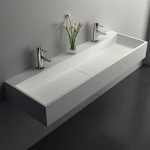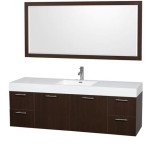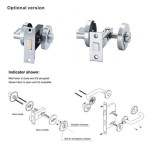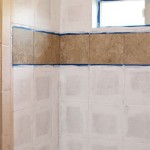Cost to Install a Bathroom Sink and Faucet: A Comprehensive Guide
The bathroom sink and faucet serve as essential fixtures within any residential or commercial space. Replacing or installing these elements can significantly impact the functionality and aesthetics of the bathroom. However, the overall cost associated with this project can vary greatly depending on numerous factors, making it essential to understand the components contributing to the final expense. This article aims to provide a comprehensive overview of the costs involved in installing a bathroom sink and faucet, offering insights into different sink and faucet types, labor expenses, and potential hidden costs. It seeks to empower homeowners to make informed decisions during this renovation or installation process.
The expense of installing a bathroom sink and faucet can be broken down into several categories, including the cost of the sink itself, the faucet cost, plumbing alterations (if needed), labor charges, and potential additional expenses like material disposal or permits. Each of these elements can fluctuate based on regional variations, the complexity of the installation, and the specific choices made by the property owner.
Sink and Faucet Selection: Impacting the Overall Cost
The first significant cost driver is the selection of both the sink and the faucet. Bathroom sinks are available in various styles, materials, and price ranges. Common types include:
- Pedestal Sinks: These standalone sinks are relatively inexpensive, typically ranging from $100 to $400. Installation is generally straightforward, but they offer minimal counter space or storage.
- Vessel Sinks: Positioned on top of the counter, vessel sinks provide a modern aesthetic. Prices range from $150 to $600, depending on the material (glass, ceramic, stone) and design complexity.
- Undermount Sinks: Installed beneath the countertop, undermount sinks offer a seamless look and ease of cleaning. These can cost between $100 and $500, excluding the cost of the countertop itself.
- Drop-in Sinks (Self-rimming sinks): These are placed into a pre-cut hole in the countertop. They are relatively easy to install, and prices range from $80 to $300.
- Vanity Sinks: Incorporated into a bathroom vanity, these sinks offer storage solutions. The cost significantly depends on the vanity material, size, and design. A vanity with a sink can range from $200 to $2000 or more.
- Wall-mounted Sinks: These sinks are attached directly to the wall, creating a space-saving design. Prices typically range from $150 to $500, not including any reinforcement that may be required within the wall.
Similarly, faucet prices vary considerably depending on the brand, finish, features, and type. Common faucet types include:
- Center-set Faucets: Designed for sinks with three holes drilled close together (typically 4 inches apart). They are often more affordable, ranging from $50 to $200.
- Single-hole Faucets: Feature a single lever for controlling both water temperature and flow. These range from $75 to $300.
- Widespread Faucets: Designed for sinks with three holes drilled further apart (typically 8 inches apart). They offer a more customizable aesthetic, with prices ranging from $100 to $400.
- Wall-mounted Faucets: Attached directly to the wall above the sink, providing a modern and space-saving look. These are often more expensive, ranging from $150 to $500 and requiring precise plumbing installation.
Beyond style, faucet features like water-saving technology, touchless operation, and special finishes (e.g., brushed nickel, oil-rubbed bronze) can also affect the price. Brand reputation and warranty offerings also contribute to the overall cost.
Generally, selecting higher-end sinks and faucets from reputable brands will naturally increase the material cost. Homeowners should balance their aesthetic preferences with their budget constraints when making these selections.
Labor Costs and Plumbing Considerations
Labor costs constitute a significant portion of the overall installation expense. Plumbers typically charge an hourly rate or a flat fee for the job. Hourly rates can range from $45 to $150, depending on the plumber's experience, location, and demand. A simple sink and faucet replacement might take 2-4 hours, while more complex installations involving plumbing modifications can take significantly longer.
Several factors can influence labor costs:
- Existing Plumbing: If the existing plumbing is in good condition and compatible with the new sink and faucet, the installation is simpler and less time-consuming. However, if the plumbing needs to be re-routed, replaced, or upgraded to meet code requirements, it will add to the labor cost. Older homes may require more extensive plumbing work due to outdated pipe materials or configurations.
- Accessibility: Difficulty accessing the plumbing connections under the sink can increase labor time. Tight spaces or obstructions may require specialized tools or techniques, adding to the overall cost.
- Sink Type: Certain sink types, like wall-mounted or vessel sinks, may require more specialized installation techniques and, therefore, higher labor costs. Wall-mounted sinks, for instance, often require additional wall support to bear the weight of the sink and water.
- Faucet Type: Similarly, wall-mounted faucets or faucets with intricate designs can be more complex to install than standard center-set or single-hole faucets.
It is crucial to obtain multiple quotes from licensed and insured plumbers before proceeding with the installation. These quotes should clearly outline the scope of work, including any potential additional charges for unforeseen plumbing issues. Verifying the plumber's credentials and reading online reviews can provide valuable insights into their expertise and reliability.
Homeowners with plumbing experience may consider DIY installation to save on labor costs. However, it is essential to be confident in one's abilities and to understand local plumbing codes. Incorrectly installed plumbing can lead to leaks, water damage, and costly repairs.
Hidden Costs and Additional Expenses
Beyond the sink, faucet, and labor expenses, several potential hidden costs can impact the overall project budget. These may include:
- Permits: Depending on local regulations, a plumbing permit may be required for sink and faucet installation, especially if it involves significant plumbing alterations. Permit fees vary by jurisdiction but can typically range from $50 to $200.
- Material Disposal: Disposing of the old sink, faucet, and any associated debris may incur additional costs. Some contractors include disposal fees in their quotes, while others charge them separately.
- Unexpected Plumbing Issues: During the installation, unexpected plumbing problems, such as corroded pipes or hidden leaks, may be discovered. Addressing these issues can add to the overall cost. A contingency fund should be allocated for such unforeseen expenses.
- Countertop Modifications: If installing a new sink requires modifications to the existing countertop (e.g., cutting a larger hole for a new sink), this can add to the project cost. Hiring a professional countertop installer may be necessary.
- New Supply Lines and Drain Pipes: Older supply lines and drain pipes may be worn and prone to leaks. Replacing them during the sink installation can prevent future problems but will add to the material and labor costs.
- Bathroom Renovation: Sometimes, a new sink and faucet installation is part of a larger bathroom renovation project. In this case, the cost must be factored into the overall renovation budget.
- Specialty Tools: Some installations may require specialized plumbing tools that the average homeowner does not possess. Renting or purchasing these tools can be an additional expense.
To mitigate these hidden costs, it is essential to thoroughly inspect the existing plumbing before starting the project and to discuss potential contingencies with the plumber. A detailed contract should outline the scope of work, payment terms, and any potential additional charges. Regular communication with the plumber throughout the project can help avoid misunderstandings and ensure that any unexpected issues are addressed promptly and within budget.
Additionally, considering energy-efficient and water-saving faucets can lead to long-term cost savings on water and energy bills. While these faucets may have a higher initial cost, the reduced utility consumption can offset the expense over time.
In summary, the cost to install a bathroom sink and faucet involves a combination of factors, including the choice of sink and faucet, labor expenses, and potential hidden costs. Careful planning, obtaining multiple quotes, and addressing any underlying plumbing issues can help manage the overall project budget and ensure a successful installation. By understanding these cost drivers, homeowners can make informed decisions and achieve their desired bathroom aesthetic while staying within their financial means.

Bathroom Vanity Installation Cost 2024 Average S

Average Cost To Install Or Replace A Faucet 2024 Forbes Home

Fixr Com Bathroom Sink Cost To Replace

Average Cost To Install Or Replace A Faucet 2024 Forbes Home

2024 Cost To Replace Bathroom Faucet

2024 Cost To Install Or Replace A Faucet In Your Kitchen And Bathroom Kege

2024 Cost To Replace Bathroom Faucet

Average Cost To Install Or Replace A Faucet 2024 Forbes Home

What S The Average Faucet Installation Cost In 2024

Replace Vanity Top And Faucet Diy Network
Related Posts







